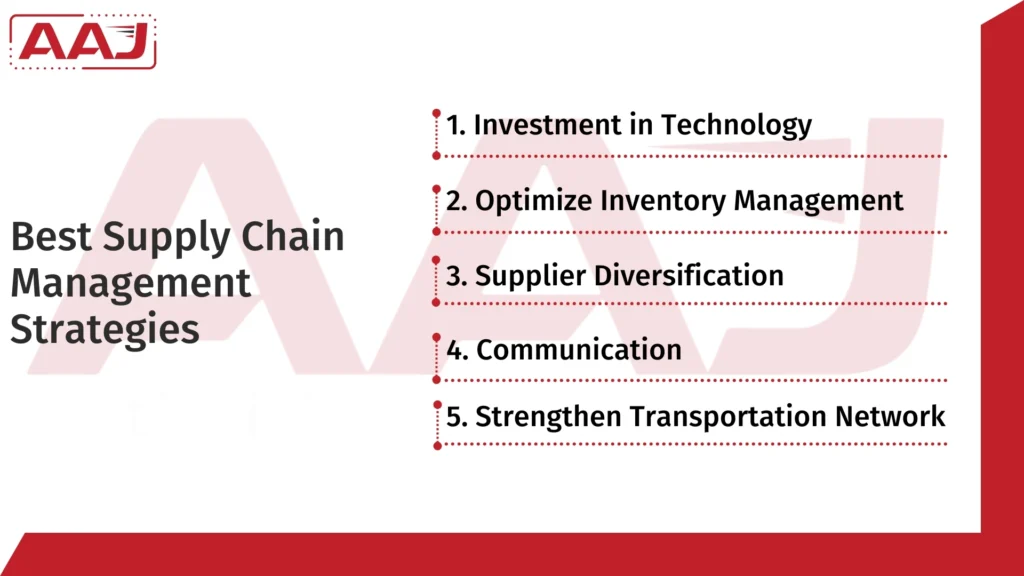Supply chain disruptions indicate disturbances in the flow of materials from sourcing to production and delivery.
These disruptions reduce revenue and decrease brand reputation in the market. Recent incidents like the COVID-19 pandemic and the Suez Canal blockage are some examples of supply chain disruptions and show how businesses faced transportation and revenue losses because of these disruptions. Businesses can mitigate risks by adopting advanced technology and collaborating with suppliers and logistics partners.
What is Supply Chain Disruption?

Supply chain disruption means unexpected events that disturb the flow of goods at any point in a supply chain.
An efficient supply chain operation involves the smooth flow of products from the supplier to the manufacturer, distributor, and finally to the customer. However, natural disasters, pandemics, or IT system failures can adversely affect the supply chain. They can delay order fulfillment and dissatisfied customers.
There are various levels of supply chain disruption, which are listed below.
1. Low
These supply chain disruptions have short-term effects. They include warehousing and transportation problems that cause delays in delivering goods and products.
2. Medium
It includes the disruptive effect that can adversely affect production for weeks or months.
3. High
It includes disruptions that adversely affect the supply chain for extended periods, such as pandemics and wars.
Examples Of Supply Chain Disruption
1. Toilet Paper
During the COVID-19 pandemic, the demand for toilet paper increased among consumers. People were afraid that toilet paper would run short in lockdown and were buying them in large amounts.
It led to empty store shelves in the U.S. and many Western countries. A stage came when suppliers struggled to meet customer demands. However, they mitigate the risk by exporting and increasing toilet paper production.
2. Apple iPhone
The COVID-19 lockdown in China negatively affected iPhone production. Hence, customers had to wait longer to get their desired iPhone.
3. 2011 Earthquake in Japan
Some businesses in Japan were adversely affected by the earthquake and tsunami in 2011. They observed a drastic reduction in both customers and suppliers. The GDP in Japan was reduced to 0.47% that year.
4. Suez Canal Obstruction
A big container ship got stuck in the Suez Canal and blocked almost 369 other ships. It continued for almost 7 days, and the ships had to either wait or take other routes for goods shipping. This issue caused businesses to lose nearly $14 to $15 million per day.
5. Cyberattack in 2017
A malware called Notpetya attacked Maersk, a shipping company. The virus spread quickly and shut down all the company’s systems. It adversely affected shipping and logistics all over the world. Research estimates that there were almost $10 billion in damages because of the cyberattack in 2017.
6.TruckDriver Shortage In 2023
Trucks transport goods most of the time in North America. A shortage of truck drivers in the USA in 2023 caused transportation issues and caused a delay in order fulfillment.
7. North American Blizzard
The heavy winter storm in North America adversely affected the eastern U.S. and Canada in 2018. It caused road blockages and flight cancellations for many days. It affected most of the business in that year.
8. Russia-Ukraine War
Crucial metals like nickel and titanium are available in Russia. They are imported to various countries, including the United States. However, the Russian-Ukrainian war stopped importing such metals to the U.S . This adversely affected various industries like automobiles and manufacturing.
Common Causes Of Supply Chain Disruptions

External Factors
- Natural Disaster: Earthquakes, floods, and hurricanes can halt supply chain operations and cause delays in delivering products.
- Pandemics: Pandemics like COVID-19 can shut down factories for specific months. The product manufacturing gets stopped for certain months, which badly affects many industries.
- War: The war between two countries can stop the importing of several important metals. It can affect automobiles, manufacturing and various other industries.
- Cyberattack: The IT system of a business can become a victim of Cyber Attacks. Various important information is leaked, and the supply chain may halt for a few days or months.
- Global Economy: Changes in currency or inflation are some of the causes of supply chain disruption.
Internal Factors
- Production Issue: Manufacturing defects in a product or quality issues can cause delays in order fulfillment.
- Labor Strikes: The company’s staff can strike, which can halt the production process.
- Human Errors: Human errors in picking packaging or entering data can involve errors, and this causes disruption in supply chain management.
- Unreliable Suppliers: If a business is working with unreliable suppliers, there may be delays in providing goods and materials.
Potential Consequences Of Supply Chain Disruptions
- Revenue Loss: Delays in supplying goods or manufacturing can cause order fulfilment delays. This can lead to lost sales and dissatisfied customers.
- Increase Wastage: Perishable goods, when stored for a longer time, can spoil and get wasted. Again, some products may get outdated if the business stores them on the warehouse storage shelf for a longer duration.
Best Supply Chain Management Strategies

- Investment in Technology: A business can adopt advanced technology like AI and machine learning to optimize supply chain operations.
- Optimize Inventory Management: Businesses should keep inventories in a way that will avoid problems like overstocking and out-of-stock issues.
- Supplier Diversification: Dependency on a single supplier can increase risks in supply chain management. Businesses need to collaborate with multiple reliable suppliers to mitigate the risks.
- Communication: The business needs to communicate with all stakeholders and have long-term supplier relationships.
- Strengthen Transportation Network: Businesses should have access to multi transport modes like air, rail, road and sea for goods transport.
Conclusion
The global supply chain market will reach $45.2 billion by 2027. However, supply chain disruptions obstruct the smooth flow of goods from one region to another. Various reasons behind the disruption can include wars, labor strikes, inflation, and more. Businesses should adopt advanced and modern strategies to reduce the risks of supply chain disruptions.




